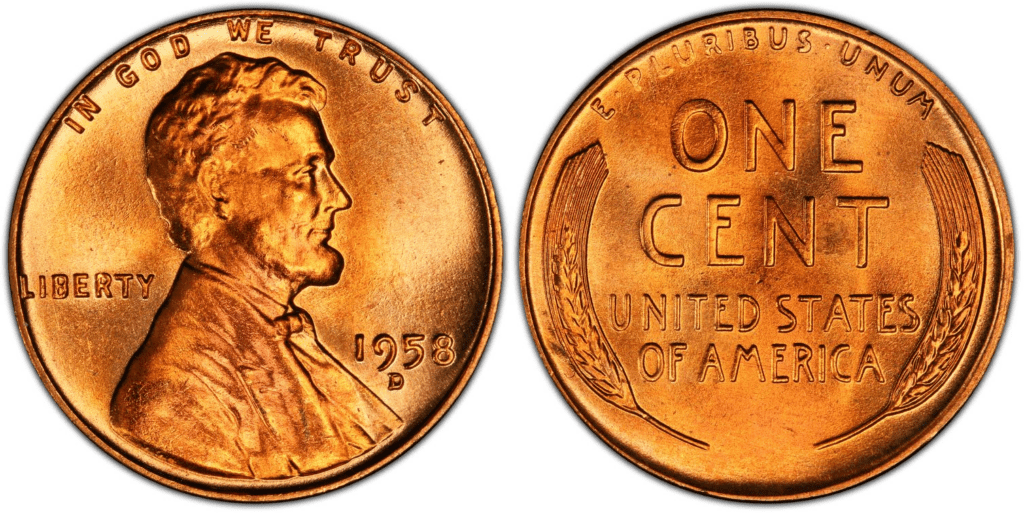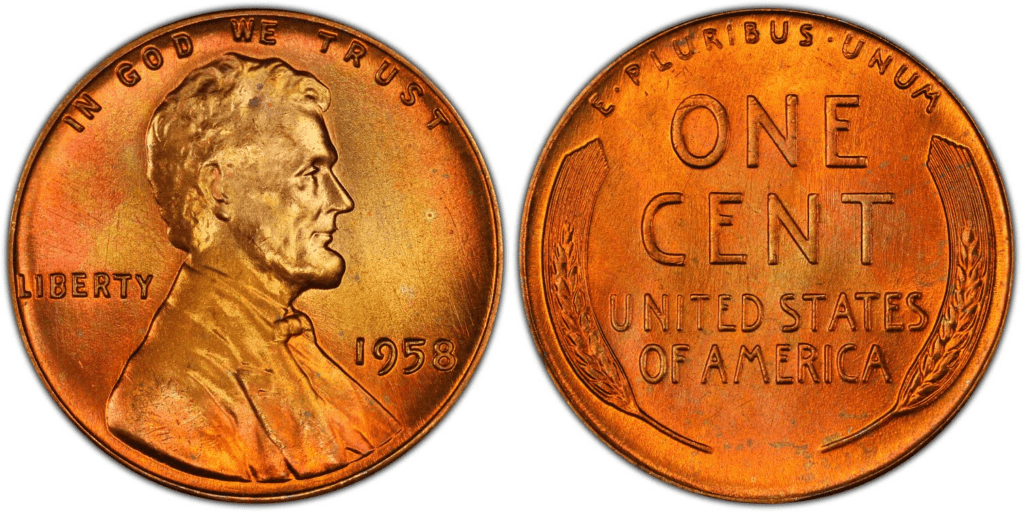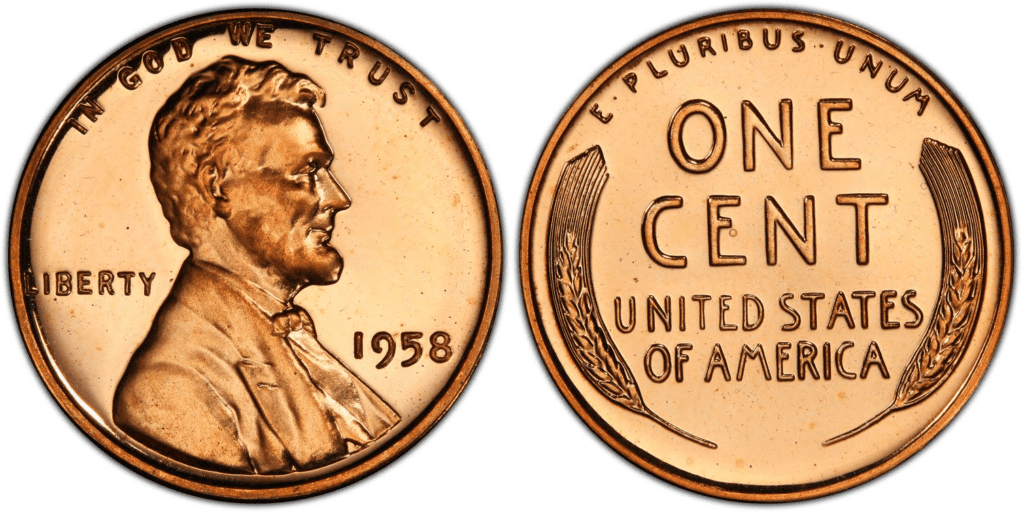What Is the 1958 Lincoln Penny Made Of?
The 1958 Lincoln penny comprises 95% copper and 5% tin and zinc. The same composition is used for pennies struck from 1909 to 1942 and 1944 to 1982. From 1982 until now, the penny has been made of 97.5% zinc and 2.5% copper.
Other specifications of the 1958 Lincoln penny are as follow:
- Value – 1 cent
- Mass – 3.11 g
- Edge – plan
- Diameter – 19mm
The Lincoln pennies struck in 1958 were designed by Victor David Brenner. He designed both the reverse and obverse of the coin. Initially, the US Mint chose Augustus Saint-Gaudens to design the penny, which would be released in 1909.
However, he died before completing the work. In January 1909, the Mint commissioned Brenner to design the penny with Abraham Lincoln as its main feature. It was a fitting tribute to the beloved president who would have also celebrated his centennial birth in 1909.

The obverse features the image of Abraham Lincoln, the 16th president of the United States. On top of his head, you’ll read, “IN GOD WE TRUST.” On the left is written “LIBERTY,” and on the right is the year of minting, which is 1958.
1958 was the final year for the Lincoln penny to have the stalks-of-wheat design. That’s why it is often called the “Wheat penny.”
On the reverse, you’ll find two stalks of wheat. On top of the coin is the US motto, “E. PLURIBUS UNUM,” Latin for “Out of many, one.” Below the US motto is the coin’s value, “ONE CENT.” Then, finally, you’ll find “UNITED STATES OF AMERICA.”
The Lincoln penny was first struck in 1909. At that time, the penny had the wheat design on the reverse. However, by 1959, the wheat design was replaced by the Lincoln Memorial design. At the time of this writing, the reverse design of the Lincoln penny was the Union Shield designed by Lyndall Bass.
An interesting fact worth mentioning here: the Lincoln wheat penny is the only coin issued in the United States that went through the Great Depression and two world wars.
1958 Lincoln Penny Varieties
The Lincoln penny in 1958 came in different varieties. These are the 1958-P, 1958-D, and 1958-P proofs. Some error coins gave rise to a new variety.
Here are the 1958 Lincoln penny varieties that you should know:
1958 D Lincoln Penny
Year of minting: 1958
Mint Mark: D
Place of minting: Denver
Quantity produced: 800,953,300
Face Value: $0.01 (one cent)
Price: $0.01 to $30.00 (or more)
Mass: 3.11 grams
Edge: Plain
Designer: Victor D. Brenner
Composition: 95% copper and 5% tin and zinc
Diameter: 19.05 mm
Thickness: 1.52 mm

photo source: PCGS
The Denver Mint produced more than 800 million 1958 D pennies. Remember that the penny is the smallest coin denomination in the United States. Thus, it is unsurprising that it has a very high number of mintage. The price range of the 1958 D penny is $0.01 to $30.00.
Looking back, the 1958 series of Lincoln penny was the final year for it to have the wheat reverse. In 1958, it was noted that the Denver Mint produced much better and nicer coins compared to the previous years. That’s why there are plenty of 1958 pennies with MS65 grade. Even pennies with MS66 and MS67 grades would still be easy to find.
1958 P Lincoln Penny
Year of minting: 1958
Mint Mark: None
Place of minting: Philadelphia
Quantity produced: 252,525,000
Face Value: $0.01 (one cent)
Price: $0.01 to $25.00 (or more)
Mass: 3.11 grams
Edge: Plain
Designer: Victor D. Brenner
Composition: 95% copper and 5% tin and zinc
Diameter: 19.05 mm
Thickness: 1.52 mm

photo source: PCGS
The Philadelphia Mint produced more than 252 million Lincoln pennies in 1958, fewer than the Denver Mint produced. The price range is 0.01 to $25.00. Some 1958 P pennies could be worth more than when sold in the open market.
1958 Lincoln Penny (Proof)
Year of minting: 1958
Mint Mark: None
Place of minting: Philadelphia
Quantity produced: 875,652
Face Value: $0.01 (one cent)
Price: $0.01 to $61.00 (or more)
Mass: 3.11 grams
Edge: Plain
Designer: Victor D. Brenner
Composition: 95% copper and 5% tin and zinc
Diameter: 19.05 mm
Thickness: 1.52 mm

photo source: PCGS
In 1958, the Philadelphia mint also produced proof coins, which were special kinds of coins. Proof coins are made for collectors. They have a better luster, attractiveness, and detail. This explains why more than 875 thousand proof coins are made since it takes a lot of time and energy to produce them.
List Of 1958 Lincoln Penny Errors
The 1958 Lincoln penny isn’t exempted from errors. As hard as the US Mint tried, there would still be a few coins with errors. That’s something you can expect for a type of coin with more than a billion Lincoln pennies; it’s just a matter of time before errors would happen.
Perhaps, the most sought-after error for the 1958 Lincoln 1 cent is the doubled die error. It is rare and super valuable. Here’s what it looks like:

If you look closely, there is some doubling of letters in the words “IN GOD WE TRUST” and LIBERTY. The 1958 year is also doubled, but it’s not as prominent as what you can see in other letters. You would need a magnifying glass or microscope to see it.
The doubled die error happens when the die hits the planchet twice. With a slight difference in angle, the second strike would cause a doubling in the inscribed elements. If the doubled die error happens on the obverse, it’s called doubled die obverse (DDO). If it’s on the reverse, it’s called doubled die reverse (DDR).
The more prominent the doubled die error is, the higher its value.
Aside from the DDO or DDR, other errors may include strike errors. For example, a weak strike would cause a blurring of the engraved elements on the coin. A strike-through error causes a foreign material to be engraved on the coin. An off-center strike causes the engraved materials to be struck at the wrong angle.
There are many more errors that happened during the minting of 1958 pennies. Though it may sound negative, coin enthusiasts are fond of collecting error coins since they are unique and rare.
How Much Is the 1958 Lincoln Penny Worth Today?
The 1958 Lincoln penny is worth 1 cent, as its face value suggests. Its melt value is slightly higher at $0.0257.
Looking at the numbers, the 1958 Lincoln penny seems to be cheap and worthless. However, let that not fool you.
1958 Lincoln pennies are astronomically worth more than their face value or melt value.
To give you an overview, here’s a 1958 Lincoln Penny values chart:
| Coin | Condition | Grade | Mintage | Value |
| 1958 D Lincoln penny | Circulated/mint | Not graded | 800,953,300 | $0.01 to $30.00 |
| 1958 D Lincoln penny | Uncirculated/mint | MS-65 | 800,953,300 | $7 to $32 |
| 1958 D Lincoln penny | Uncirculated/mint | MS-66 | 800,953,300 | $15 to $22 |
| 1958 D Lincoln penny | Uncirculated/mint | MS-67 | 800,953,300 | $84 to $504 |
| 1958 P Lincoln penny | Circulated/mint | Not graded | 252,525,000 | $0.01 to $25.00
|
| 1958 P Lincoln penny | Uncirculated/mint | MS-65 | 252,525,000 | $20 to $39 |
| 1958 P Lincoln penny | Uncirculated/mint | MS-66 | 252,525,000 | $16 to $39 |
| 1958 P Lincoln penny | Uncirculated/mint | MS-67 | 252,525,000 | $192 to $480 |
| 1958 Proof Lincoln penny | Circulated/proof | Not graded | 875,652 | $0.01 to $61.00 |
| 1958 Proof Lincoln penny | Uncirculated/proof | PR-67 | 875,652 | $44 to $175 |
| 1958 Proof Lincoln penny | Uncirculated/proof | PR-68 | 875,652 | $55 to $432 |
| 1958 Proof Lincoln penny | Uncirculated/proof | PR-69 | 875,652 | $460 to $840 |
As you can see, the 1958 Lincoln penny can be worth a lot of money. To give you more idea, check out the auction records for the 1958 Lincoln penny.
According to PCGS, among the 1958 Lincoln pennies, the highest auction record is $12,338. It’s a proof coin with PR68DC grade, sold by Heritage Auctions in June 2017.
For the 1958-P variety, the auction record is $9,000; for the 1958-D, the auction record is $3,360. If you think about it, that’s a lot of money for a coin with a face value of 1 cent.
How Does The Grading System Work?
The Sheldon Scale is used by numismatists to provide a numerical value to coins. The Sheldon Scale goes from poor (P-1) to perfect mint state (P-1) (MS-70). Coins were originally evaluated using words to reflect their condition (Good, Fair, Excellent, Etc.). Unfortunately, coin collectors and dealers had different ideas about what each of these terms represent.
Professional numismatists joined together in the 1970s and established CoinGrading standards. These numismatists now assign grades at key places on the seventy-point scale, using the most regularly utilized numeric points in conjunction with the original adjective grade. The following are the most common coin grades:
-
-
- (P-1) Poor – Indistinguishable and probably damaged; if used, must have a date and mintmark; otherwise, rather battered.
- (FR-2) Fair – Nearly smooth, but without the damage that a coin graded Poor often possesses. The coin must have enough detail to be identified.
- (G-4) Fair – Inscriptions have merged into the rims in some areas, and important elements have been mostly erased.
- (VG-8) Very Good- A little weathered, but all of the primary design elements are visible, albeit faintly. There is little if any, central detail left.
- (F-12) Good – The item is very worn, yet the wear is even, and the overall design details stand out clearly. Rims are almost completely isolated from the field.
- (VF-20) Very Fine – Moderately weathered, with some finer features still visible. The motto or all letters of LIBERTY are readable. Both sides of the coin have entire rims that are separated from the field.
- (EF-40) Extremely Fine – Gently used; all gadgets are visible, and the most important ones are bold. The finer details are bold and clear, however, light wear may be seen.
- (AU-50) Uncirculated – Slight evidence of wear on the coin’s design’s high points; may have contact marks; eye appeal should be adequate.
- (AU-58) Uncirculated Choice – Slight traces of wear, no severe contact marks, almost full mint shine, and great eye appeal.
- (MS-60) Mint State Basal – Strictly uncirculated; no indication of wear on the coin’s highest points, but an unsightly coin with reduced luster, visible contact marks, hairlines, and other flaws.
- (MS-63) Mint State Acceptable – Uncirculated, but with contact scratches and nicks, little reduced shine, but otherwise appealing appearance. The strike is weak to average.
- (MS-65) Mint State Choice – Uncirculated with great mint shine, very little contact blemishes, and exceptional eye appeal. The strike is unusually severe.
- (MS-68) Mint State Premium Quality – Uncirculated with superb luster, no obvious contact marks to the naked eye, and exceptional eye appeal. The strike is quick and appealing.
- (MS-69) Almost Perfect Mint State – Uncirculated with perfect brilliance, a sharp and appealing strike, and extremely good eye appeal. A near-perfect coin with minor imperfections in the planchet, strike, and contact markings (seen only under 8x magnification).
- (MS-70) Mint State Perfect – Under 8x magnification, there are no tiny imperfections discernible; the strike is crisp, and the coin is perfectly centered on a beautiful planchet. Rarely seen on a coin, this coin is bright and whole, with original luster and exceptional eye appeal.
-
Are There Any Rare 1958 Lincoln Penny?
The rarest 1958 Lincoln penny has the doubled die obverse error. Because the planchet was struck twice, the engraved elements, especially the letters in “IN GOD WE TRUST” and “LIBERTY,” doubled. The error is so prominent that you can see it easily with your naked eyes.
As mentioned, the more prominent the doubled die error is, the higher its price. That’s why the rare 1958 doubled die obverse error was sold for $336,000 during an auction held by Stack’s Bowers in March 2018.
Aside from the doubled die 1958 penny, pennies with grades of at least MS 68 or PR 68 can be considered rare since just a few of these coins exist today.
Where To Buy Or Sell 1958 Lincoln Penny?
The 1958 Lincoln penny is available on the Internet and in brick-and-mortar stores. Some of the most popular websites would include the following:
- Amazon
- Etsy
- eBay
- USA Coin Book
- Grey Sheet
- Coin Appraiser
Aside from the Internet, the following could be a good place to buy and sell your 1958 penny:
- Coin shops
- Antique stores
- Pawnshops
- Auction houses
FAQs
How much is a 1958 D Lincoln penny error worth?
The value of the 1958 D Lincoln penny error would depend on the type of error and condition of the coin. Penny errors would normally be around hundreds of dollars. If the penny error is rare, its value could reach thousands of dollars.
What makes a 1958 penny valuable?
The 1958 penny becomes valuable when it is rare and, at the same time, kept in good condition. Moreover, if there’s a great demand for a particular penny, but the supply is low, then you can expect that that penny would have a higher value.
How do I know if my 1958 penny has doubled die errors?
By looking at its engraved elements, you can know that a 1958 penny has a doubled die error. If you see a doubling of the letters, numbers, or images, then it could be a doubled die error. You can get in touch with a qualified and trusted appraiser to confirm.



